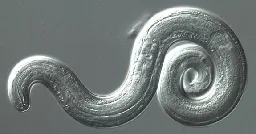Burning in woman’s legs turned out to be slug parasites migrating to her brain
Burning in woman’s legs turned out to be slug parasites migrating to her brain
After three trips to the ER, woman gets diagnosis of dreaded rat lungworm.
It started with a bizarre burning sensation in her feet. Over the next two days, the searing pain crept up her legs. Any light touch made it worse, and over-the-counter pain medicine offered no relief.
On the third day, the 30-year-old, otherwise healthy woman from New England went to an emergency department. Her exam was normal. Her blood tests and kidney function were normal. The only thing that stood out was a high number of eosinophils—white blood cells that become active with certain allergic diseases, parasitic infections, or other medical conditions, such as cancer. The woman was discharged and advised to follow up with her primary care doctor.
...
In a case report published in the New England Journal of Medicine, doctors explain how they figured out the source of her fiery symptoms—worms burrowing into her brain. By this point, she was alert but disoriented and restless. She couldn't answer questions consistently or follow commands.
The doctors at Mass General, including a neurologist specializing in infectious diseases, quickly focused their attention on the fact that the woman had recently traveled. Just four days before her feet began burning, she had returned from a three-week trip that included stops in Bangkok, Thailand; Tokyo, Japan; and Hawaii. They asked what she ate. In Thailand, she ate street foods but nothing raw. In Japan, she ate sushi several times and spent most of her time in a hotel. In Hawaii, she again ate sushi as well as salads.
...
Scanning for data on infections that can arise in the three places she visited and align with her symptoms, they came up with a list of 10 possible infectious causes: eight parasites and two fungal pathogens. They went through them one by one, crossing things off the list that didn't quite fit with everything they knew of her case. They ended with angiostrongyliasis, caused by the nematode (roundworm) Angiostrongylus cantonensis, also known as rat lungworm.
...
Given the alignment of symptoms and the raw seafood and salads eaten in Hawaii, the doctors gave a presumptive diagnosis of central nervous system angiostrongyliasis. The diagnosis was confirmed with a genetic test for the parasite's DNA in the patient's cerebrospinal fluid (nucleic acid amplification testing).
There are no clear treatment strategies for angiostrongyliasis, and some can recover fully without treatment after the larvae die off. In this case, the patient and her doctors decided to use a 14-day combination of the immunosuppressive steroid prednisone and the anti-parasitic drug albendazole.
Fortunately, the woman's symptoms cleared with the treatment, and she was discharged from the hospital after six days.
